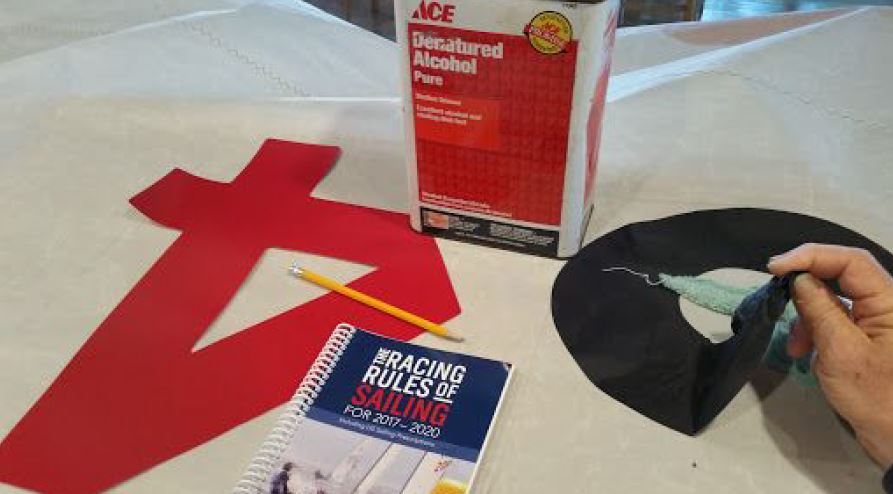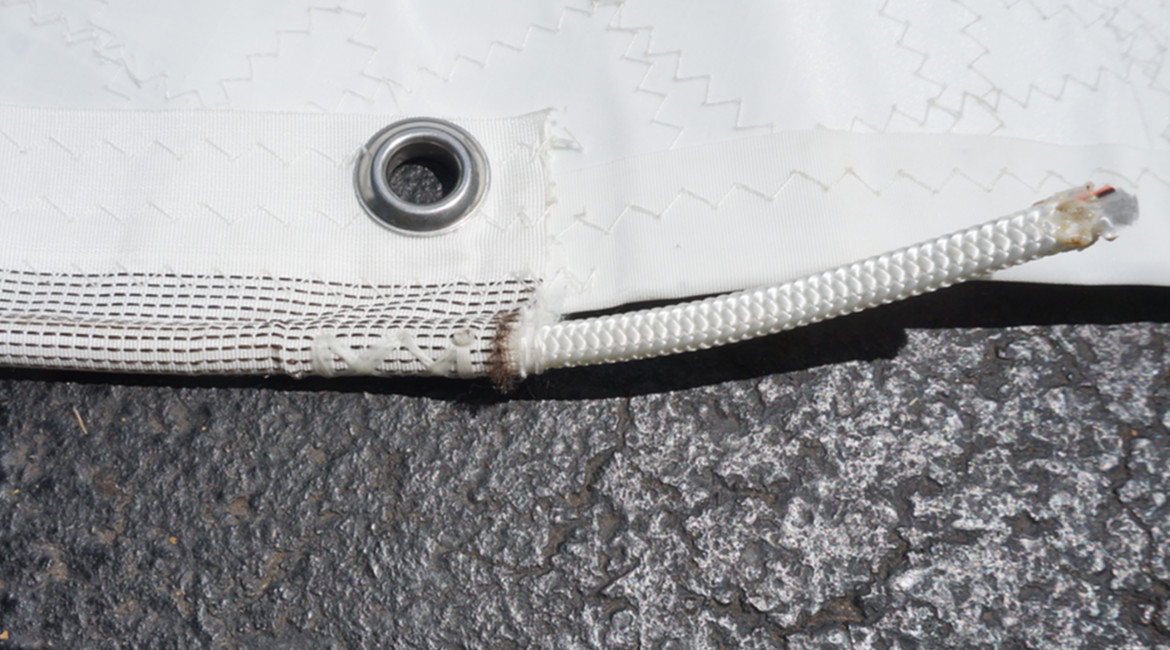Sometimes a previously used sail comes your way and you need to replace the sail numbers. If you have replacement numbers, you can do it yourself.
Step-by-step instructions
SailZing.com guest contributor Richard Beers, an E Scow and MC Scow sailor, shows how in this pdf document. Click on the link to read his step-by-step instructions.
FAQs
Can I use acetone to remove the old adhesive?
Richard recommends denatured alcohol. Either acetone or denatured alcohol will work. Neither solvent will damage the sail. Denatured alcohol is less aggressive and won’t remove your pencil lines. Keep either solvent away from colored letters.
If the adhesive is hard to remove, soak a paper towel in the solvent and lay it on the adhesive for awhile.
Where can I get numbers?
Typically, you will get new numbers from your sail maker. Another source is SailRite.
Tell me more about number size and spacing
If you’re placing numbers from scratch, use the class rules for size and spacing (see below).
If the class rules do not specify spacing, use a proportional spacing. For example, for 15″ numbers, use a spacing of about 3″ between numbers. If the numbers “nest” together – like a 7 and 4, measure the 3″ at the closest point between the nested numbers; otherwise they will look too far apart.
How do I avoid wrinkles?
As Richard points out in his article, applying the numbers without wrinkles takes care. Even if the sail is flat, it’s easy to get wrinkles.
You might consider using different techniques for different numbers. See the diagram below.
- Open figures with flat bottoms: 1, 2, 7. Just start at the bottom of the number, peeling a little backing paper off, and following the shape while peeling adhesive off.
- Closed figures or rounded bottoms: 0, 3, 4, 5, 6, 8, 9. The closed figures are harder to avoid wrinkles.
- Get the bottom of the figure aligned first. Then start at the bottom and peel a little backing off, working your way up vertically, pulling off the backing as you go.
- 4 and 9. If you really want to be careful, you can open up these numbers by making a slit in both the number and the backing. See the diagram.

Rules regarding sail numbers
Here are excerpts from the Scow, X, and Opti class rules regarding sail numbers.
A Scow
- Sail Numbers and Class Insignia
- Sail numbers of contrasting color with lake designator shall be displayed on the mainsail at all times. 20” numbers and letters are required.
- Class A insignia shall be displayed on the mainsail at all times located in the top 1/3 of the mainsail at the 50% position.
E Scow
- Each yacht shall carry her assigned racing number and club letter designator as follows:
- On both sides of her mainsail. On both sides of her after-deck.
- The size and placement of the racing numbers shall be as follows:
- For mainsail, 18” min., 20” max. placed in accordance with the official sail-letter placement diagram and as follows: with vertical centerline 20” of the leading edge of batten No. 2, and with vertical spacing 12” between all club designator letters and/or racing numbers.
- On the after-deck, 10” in height, place approximately parallel to her rub-rail, facing outboard and in line.
- The character and legibility of the club designator and racing numbers shall be as follows:
- On sails, they shall be of widely solid contrasting colors, such as dark numbers on white or light colored sails, and white or light colored on dark material.
- Deck numbers shall be of widely contrasting color to the deck color for easy legibility.
- All letters and numbers shall be of a clear cut, vertical, block type design without serif. The stroke shall be 2.5” min., 3.5” max.
- On sails, letters and numbers may be either marked directly on the sail material or may be of a separate material securely attached thereto.
- On the deck, letters may be either painted directly thereon or may be a plate or in individual letters securely affixed to the deck.
- Letters on sails, or numbers on sails, shall not be back to back nor at the same level above the boom except where letters or numbers are symmetrical and would show identically on both sides of the sail.
Class C and X
- Each yacht must carry on both sides of her mainsail a letter, representing the Member Club from which she is entered, as well as her correct assigned racing number. Any whole integer between 0-999 is allowed. The integer ‘0’ may be represented by ‘0’, ‘00’, or ‘000;’ no other integers shall include leading zeros. The letter and number shall be placed on the sails in accordance with the official sail-letters placement diagram. Sails which have more than one club designator letter shall show the designator letters closely side by side on the same plane. An emblem, letter, or number denoting the class to which the yacht belongs may be affixed, as provided in the Class Scantlings.
- Letters and numbers must be either all blue, red, green, pink, or black of a sans serif, non-italic, non-script font style attached directly to the sail by sewing and/or adhesive. All sails shall have letters and numbers of the same color with a minimum stroke width of 2.5″ and a maximum stroke width of 3.5″.
- Letters and numbers shall be on both sides of the sail and shall not be back to back except where letters and numbers show identically the same on both sides of the sail. Letters and numbers when not back to back shall be higher on the starboard side of the sail.
- Letters shall be placed between the top and first lower battens and numbers between the first lower and second lower battens as shown, with approximately even space vertically between them and according to the following specifications:
- Height of letters and numbers: Class C, 18-20″; Class X, 14-16″.
- Centerline of letters and numbers will be located aft the leading edge of the first lower batten as follows, plus or minus 2″: Class C, 36″; Class X, 8″.
- Vertical spacing between letters and numbers will be no less than: Class C, 10″; Class X, 8″.
MC Scow
- MC insignia: The official class insignia for the MC Scow shall be the letter “C” superimposed over the letter “M”. This symbol shall appear on all sails, in letters 15″ in height and of proportional width.
- Sail numbers: Each sail shall bear the number of the yacht in figures of the same proportion as the sail symbol.
- The MC insignia shall he located above the sail numbers. Both shall be located in or near the upper half of the sail.
Optimist
Here’s a diagram showing the key rules for placement. The full set of rules is shown below:
- Numbers and letters on sails shall be of the following dimension
- Height: 230 mm – 240 mm
- Width (except “1” or “I”): 150 mm – 160 mm
- Width for M and W: 160 mm – 170 mm
- Thickness: 30 mm – 40 mm
- The national letters shall be placed on the same line on opposite sides of the sail with letters on the starboard side of the sail closer to the luff than those on the port side of the sail. The numbers shall be placed in two rows below the letters with the starboard side numbers uppermost. The following spacing shall apply:
- Space between adjoining numbers or letters: 40 mm-50 mm
- Space between rows of numbers or letters: 40 mm – 50 mm
- Space between the national letter groups on opposite sides of the sail: 100 mm -150 mm
- Distance between the luff and the closest letter or number in each row: 150 mm
- Distance between lower edge of uppermost batten pocket and the national letter which is closest to the leech: 40 mm – 50 mm
- Distance between number closest to the leech and the leech: as per RRS Appendix G1.2(b)



